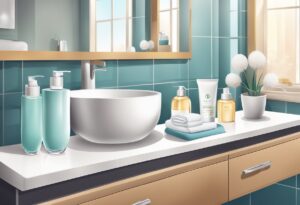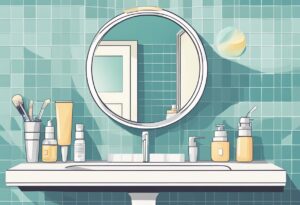Pimples are a common skin problem that affects people of all ages. They can be caused by various factors such as hormonal changes, stress, poor diet, and improper skincare. While pimples are not harmful, they can be unsightly and may affect one’s self-esteem.
Fortunately, there are several ways to remove pimples at home.

One of the most effective ways to remove pimples at home is to maintain good skincare habits. This includes washing your face twice a day with a gentle cleanser, avoiding harsh scrubs or exfoliants, and using non-comedogenic (non-pore-clogging) products. Additionally, applying a spot treatment containing benzoyl peroxide or salicylic acid can help to dry out and reduce the size of pimples.
Another home remedy for pimples is to use natural ingredients such as tea tree oil, aloe vera, and honey. These ingredients have antibacterial and anti-inflammatory properties that can help to soothe and heal pimples. However, it is important to note that natural remedies may not work for everyone and may cause irritation or allergic reactions in some individuals. It is always best to do a patch test before using any new product on your skin.
Understanding Acne

Types of Pimples
Acne is a common skin condition that affects millions of people worldwide. It is characterized by the appearance of pimples, which can be of different types. The most common types of pimples include:
- Whiteheads: These are small, raised bumps that have a white or yellowish head. They occur when the pores of the skin become clogged with oil, dead skin cells, and bacteria.
- Blackheads: These are similar to whiteheads, but they have a black or dark appearance. They occur when the clogged pores are exposed to air and oxidize.
- Papules: These are small, red bumps that are tender to the touch. They occur when the walls of the hair follicles become inflamed.
- Pustules: These are similar to papules, but they have a white or yellowish center. They occur when the inflammation causes the follicle to fill with pus.
- Nodules: These are large, painful bumps that are deep under the skin. They occur when the inflammation affects the deeper layers of the skin.
- Cysts: These are similar to nodules, but they are filled with pus. They occur when the inflammation causes the follicle to rupture and spill its contents into the surrounding skin.
Causes of Acne
Acne is caused by a combination of factors, including:
- Excess oil production: When the sebaceous glands in the skin produce too much oil, it can clog the pores and lead to acne.
- Dead skin cells: When the skin sheds dead skin cells, they can clog the pores and lead to acne.
- Bacteria: The skin is home to a type of bacteria called Propionibacterium acnes (P. acnes), which can cause acne when it grows out of control.
- Hormones: Hormonal changes, such as those that occur during puberty, pregnancy, or menstruation, can lead to acne.
- Genetics: Some people are more prone to acne due to their genetics.
It is important to understand the types of pimples and the causes of acne in order to effectively treat and prevent this common skin condition.
Preventive Measures

Daily Skin Care Routine
Maintaining a daily skin care routine is crucial to preventing pimples. This routine should include cleansing, toning, moisturizing, and exfoliating. Using a gentle cleanser twice a day, in the morning and at night, can help remove excess oil and dirt from the skin. Toning can help balance the pH level of the skin, while moisturizing can help keep the skin hydrated and prevent dryness. Exfoliating once or twice a week can help remove dead skin cells and unclog pores.
It is important to choose products that are suitable for one’s skin type. For oily skin, products that contain salicylic acid or benzoyl peroxide can be effective in preventing pimples. For dry or sensitive skin, products that are gentle and fragrance-free are recommended.
Lifestyle Considerations
In addition to a daily skin care routine, there are several lifestyle considerations that can help prevent pimples. Eating a healthy and balanced diet, drinking plenty of water, and getting enough sleep can all contribute to healthy skin. Stress can also contribute to the development of pimples, so managing stress through techniques such as meditation or exercise can be helpful.
It is also important to avoid touching the face, as this can transfer bacteria and oil from the hands to the skin. Using clean towels and pillowcases can also help prevent the spread of bacteria. Finally, avoiding harsh chemicals and irritants, such as certain makeup products or detergents, can help prevent pimples.
By following these preventive measures, one can reduce the likelihood of developing pimples and maintain healthy, clear skin.
Home Remedies

Natural Ingredients
Many natural ingredients can help remove pimples at home. Here are some effective ones:
- Tea Tree Oil: This essential oil has antibacterial properties that can help reduce inflammation and redness caused by pimples. Apply a few drops of tea tree oil on the affected area using a cotton swab or ball.
- Aloe Vera: Aloe vera has anti-inflammatory properties that can help soothe the skin and reduce redness and swelling. Cut a fresh aloe vera leaf and apply the gel on the affected area.
- Honey: Honey has antibacterial properties that can help kill the bacteria causing pimples. Apply raw honey on the affected area and leave it on for 15-20 minutes before rinsing it off.
- Lemon Juice: Lemon juice has natural astringent properties that can help dry out pimples and reduce oiliness. Apply fresh lemon juice on the affected area using a cotton ball and leave it on for 10-15 minutes before rinsing it off.
Over-the-Counter Products
If natural remedies don’t work, over-the-counter products can help. Here are some effective ones:
- Benzoyl Peroxide: This ingredient can help kill the bacteria causing pimples and reduce inflammation. It is available in different strengths and forms such as creams, gels, and washes.
- Salicylic Acid: This ingredient can help unclog pores and prevent new pimples from forming. It is available in different strengths and forms such as creams, gels, and pads.
- Sulfur: This ingredient can help dry out pimples and reduce oiliness. It is available in different forms such as creams, ointments, and masks.
It is important to follow the instructions on the product label and avoid using too many products at once as it can irritate the skin.
Application Techniques

Spot Treatment
When it comes to spot treatment of pimples, it’s important to use the right products and techniques to avoid further irritation. One effective method is to use a cotton swab or clean finger to apply a small amount of tea tree oil directly onto the pimple. Tea tree oil has natural antibacterial properties that can help reduce inflammation and redness. Another option is to use a spot treatment containing benzoyl peroxide, which can help dry out the pimple and kill bacteria.
Face Mask Application
Face masks can be a great way to treat pimples and improve overall skin health. To apply a face mask, start by washing your face and patting it dry. Then, use a brush or your fingers to apply the mask evenly over your face, avoiding the eye and mouth areas. Leave the mask on for the recommended amount of time, usually 10-15 minutes, before rinsing it off with warm water. Some effective ingredients to look for in face masks include clay, salicylic acid, and sulfur, which can help absorb excess oil and unclog pores. It’s important to choose a mask that is appropriate for your skin type and to follow the instructions carefully to avoid irritation.
Remember, while these techniques can be effective for treating pimples at home, it’s important to maintain a consistent skincare routine and to consult a dermatologist if you have persistent or severe acne.
Aftercare and Maintenance

Moisturizing and Hydration
Moisturizing and hydration are essential for maintaining healthy skin after removing pimples. It is important to keep the skin hydrated to prevent it from becoming dry and flaky. Dry skin can lead to the formation of new pimples, which can be frustrating and counterproductive.
To keep the skin hydrated, it is recommended to use a gentle moisturizer that is suitable for your skin type. Look for a moisturizer that is non-comedogenic, meaning it won’t clog your pores. Apply the moisturizer twice a day, in the morning and at night, after cleansing your face.
In addition to using a moisturizer, it is also important to drink plenty of water to keep the skin hydrated from the inside out. Drinking water helps to flush out toxins from the body, which can contribute to the formation of pimples.
Sun Protection
After removing pimples, it is important to protect the skin from the harmful effects of the sun. Sun exposure can cause skin damage and premature aging, which can make the skin more susceptible to pimples.
To protect the skin from the sun, it is recommended to use a broad-spectrum sunscreen with an SPF of at least 30. Apply the sunscreen generously to all exposed areas of the skin, including the face, neck, and hands. Reapply the sunscreen every two hours, or more frequently if you are swimming or sweating.
Wearing a hat and staying in the shade during peak sun hours can also help to protect the skin from the sun’s harmful rays. By taking these simple steps, you can help to maintain healthy, clear skin after removing pimples at home.
